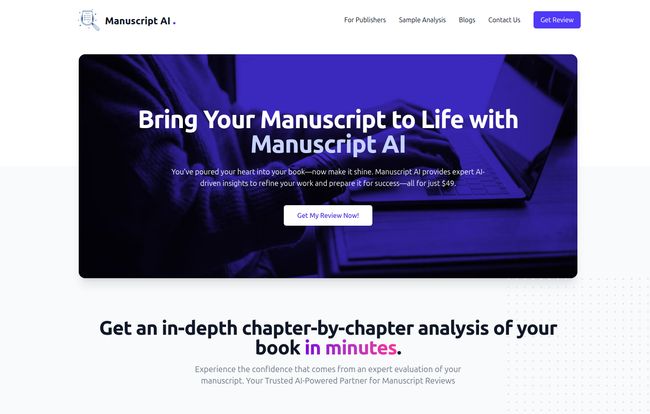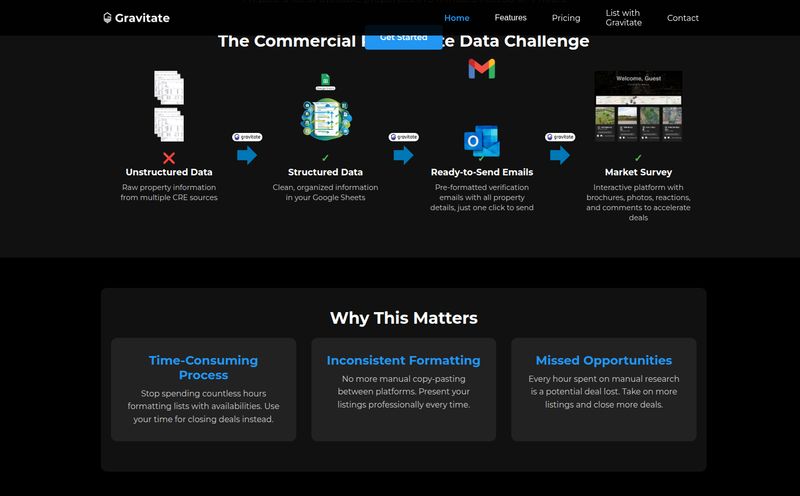Writing a book is a lonely, often brutal, slog. You pour your heart, soul, and probably way too much caffeine into this document, and then what? You're left staring at 80,000 words, wondering, “Is this… any good?” You’re too close to it. Your spouse is too nice to tell you the truth. And beta readers? God love ‘em, but finding reliable ones can be like panning for gold in a puddle.
For years, the next step was always the same: fork over a significant chunk of change for a developmental editor. And while a good human editor is worth their weight in gold, that first round of feedback can be a massive investment, especially when you're not even sure the core of your story is working.
So, when I stumbled upon a tool called Manuscript AI, my curiosity was definitely piqued. An AI that gives your manuscript a full work-over for less than the price of a fancy dinner? It sounded almost too good to be true. I’ve seen my fair share of gimmicky writing software, so I went in with a healthy dose of skepticism. Here’s what I found.

Visit Manuscript AI
So What Exactly Is Manuscript AI?
Think of Manuscript AI as a pre-editor. It’s an AI-powered platform designed to give your manuscript a comprehensive structural check-up. You upload your book, and in a shockingly short amount of time, it spits out a detailed report analyzing everything from pacing and plot structure to readability and content consistency. It's not here to correct your spelling or fix a misplaced comma—your word processor does that. This is about the big picture, the bones of your story.
The whole process is ridiculously simple. You tell it a bit about your book, upload your manuscript (it does have to be in Word format, which is a minor drag for the Scrivener die-hards), and then you wait. But not for long. We're talking minutes, not weeks. The speed alone is a pretty big selling point for impatient writers like myself.
Breaking Down the AI-Powered Assessment Report
Okay, so it's fast. But is the feedback any good? This is where I was ready to be disappointed, and honestly, I was pleasantly surprised. The report you get is a full-color, multi-page PDF that’s surprisingly easy to digest.
Getting a Bird's-Eye View with Structural Analysis
The first thing it gives you is a high-level structural analysis. It looks at the pacing of your entire book. Is your beginning too slow? Does the middle sag like a wet noodle? Does the climax actually feel like a climax? It flags these potential issues, giving you a roadmap of where to focus your revision efforts. It's like having a GPS for your plot holes.
The Magic of the Chapter-by-Chapter Breakdown
This was the feature that really impressed me. Manuscript AI breaks your book down chapter by chapter, providing summaries, word counts, estimated reading times, and readability scores. It even presents this in handy charts and graphs. Why is this cool? You can see, at a glance, if one chapter is wildly longer than the others, or if your readability suddenly plummets in a section that’s supposed to be clear and action-packed. It’s an incredible tool for spotting inconsistencies you’d never notice on your own.
Identifying Those Awkward Weak Points
The AI is also trained to identify potential weak points in your writing. It checks for things like consistent writing style and accessibility. One of the neatest tricks is that you can ask it specific questions about your manuscript, and it provides tailored answers. It’s not quite a conversation, but it's a step up from static feedback.
The Million-Dollar Question: AI vs. a Human Editor
Alright, let's address the elephant in the room. Is this thing going to put my favorite editor, Sarah, out of a job? Absolutely not. And I think the creators of Manuscript AI would agree.
An AI, no matter how clever, isn't going to understand the subtle emotional resonance of your prose. It can’t tell you if your main character’s motivation feels authentic or if a line of dialogue is pure poetry. That’s the magic of human experience and expertise. What this tool does do, however, is bridge the gap. It cleans up the big, glaring structural problems before you send your work to a human.
Think about it. You’re paying a human editor by the hour or by the word. Do you want them spending their expensive time telling you that your pacing in Act II is off and Chapter 7 is twice as long as all the others? Or do you want them to focus on deepening your characters and sharpening your themes? By using a tool like Manuscript AI first, you're sending your editor a much cleaner, more coherent draft. You save them time, which in turn, saves you money and gets you much higher-quality feedback on the stuff that really matters.
Let’s Talk Turkey: The Price Tag
This is often the sticking point for any new software. The pricing for Manuscript AI is, as they put it, “Simple.” And it really is. It’s a one-time fee of $49 for a full Manuscript Assessment Report. That’s it. No subscriptions, no hidden fees. You pay once, you get your report.
| Plan | Price | What's Included |
|---|---|---|
| Manuscript Assessment Report | $49 (One-Time) | Full-color PDF report, structural analysis, chapter breakdown, readability scores, answers to your questions, charts and graphs. |
When you consider that a developmental edit for a novel can easily run from $1,000 to $5,000 or more, spending $49 to fix the foundational issues beforehand seems like a pretty smart move. It's an incredibly low-risk investment for potentially massive returns in the quality of your finished book.
So Who Should Use Manuscript AI?
In my opinion, this tool is almost perfect for a few key groups of people:
- First-time Authors: If you've just finished your first draft (congrats!), this is an amazing, non-judgmental first reader that can help you see your work objectively.
- Self-Publishing Indies: For authors on a budget who need to make every dollar count, this is a fantastic way to polish your manuscript before it goes to a final proofreader.
- NaNoWriMo Participants: You've just smashed out 50,000 words in a month. It’s probably a glorious mess. This tool can help you find the story hidden inside that chaos.
- Seasoned Authors: Even experienced writers can benefit from a quick, unbiased check to ensure their structure and pacing are on point before diving into deeper edits.
Frequently Asked Questions
Do you only assess non-fiction books?
From what I've seen, the platform seems geared toward analyzing narrative structure, which suggests it works best for fiction but could likely provide valuable feedback on narrative non-fiction as well. The FAQ on their site should clarify the specific genres they support best.
How does the manuscript evaluation actually work?
It uses sophisticated AI algorithms to read and analyze your text. The AI looks for patterns in plot structure, pacing, sentence length, word choice, and other metrics to build its report. It compares your manuscript's structure to established storytelling conventions to identify areas that might not be working as intended.
Are the recommendations generic or specific to my book?
Both. It gives you general best-practice advice based on its analysis, but the data it's drawing from is 100% your own manuscript. The pinpoint recommendations for specific chapters are directly tied to the content you uploaded, making the feedback highly relevant.
How long does it take to get the report back?
Their site says you'll get your analysis back in minutes. This is one of its biggest advantages over traditional feedback methods, which can take weeks or even months.
Is it a substitute for a human editor?
Nope. Think of it as a powerful first step. It's a tool for developmental and structural feedback. You will still need a human for copy editing, line editing, and proofreading to catch nuanced errors and make your prose truly sing.
My Final Verdict
Look, I’m a big believer in writers helping writers, and I'm also a tech nerd who loves seeing how new tools can help us create better art. Manuscript AI hits a sweet spot. It’s affordable, fast, and provides genuinely useful, objective feedback that can make the daunting task of revision feel much more manageable. It won't replace the human touch, but it was never meant to. Instead, it acts as a powerful, unbiased assistant, giving your manuscript a solid foundation before you take it to the next level. For forty-nine bucks, it’s one of the best investments a budding author could make.



